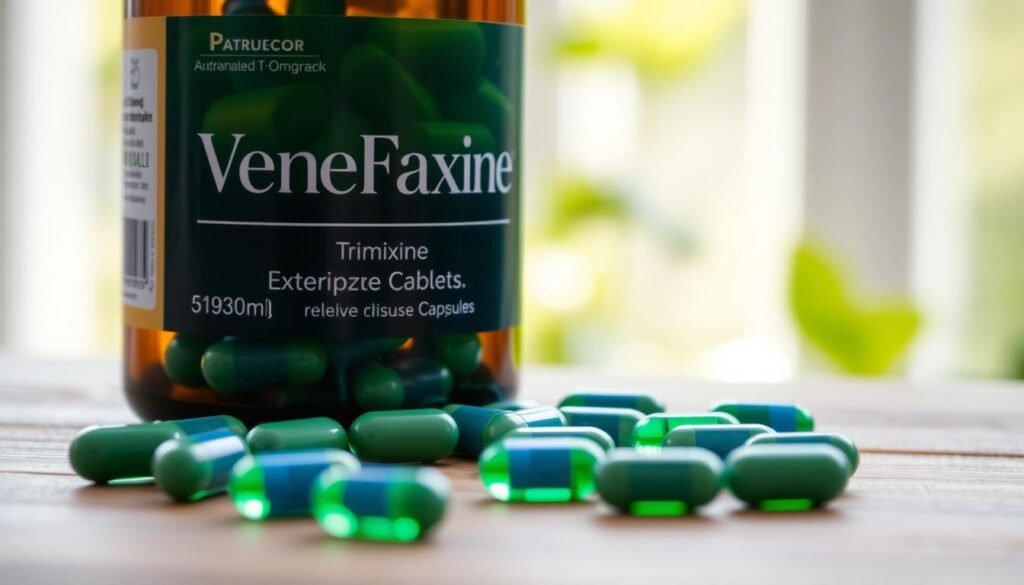About 40 million adults in the US have anxiety disorders. This big number shows we need good treatments. Effexor XR, a venlafaxine extended-release brand, is often chosen for anxiety. This guide will talk about the right Effexor dosages for those dealing with mental health issues.
Getting the Effexor dosage right is key to treating anxiety effectively. Patients need to follow the guidelines and talk to their doctors. For more information on side effects and safety, see the official Effexor XR info.
Key Takeaways
- Effexor XR works well for different anxiety disorders.
- The starting dose depends on the type of anxiety.
- It’s important to watch for side effects during treatment.
- Talking to a doctor about dosage changes is key.
- Using management strategies can make treatment more effective.
Understanding Effexor and Its Uses
Effexor is known for treating anxiety and depression. It’s a type of drug called a serotonin-norepinephrine reuptake inhibitor (SNRI). It works by upping two key brain chemicals, serotonin and norepinephrine. These help control your mood and can make you feel better.
Doctors prescribe Effexor for several conditions. These include major depression, generalized anxiety disorder (GAD), social anxiety, and panic attacks. Knowing how Effexor helps is important for patients. It’s crucial to follow your doctor’s orders when taking this medicine. Quitting suddenly can cause major problems.
Before taking Effexor, you need to tell your doctor about any health issues. Things like bleeding disorders, heart disease, or a history of seizures are especially important. Effexor can react with certain medicines, like some anti-fungals and MAOIs. Regular check-ups are key to make sure the medication is working right.
The table below shows important facts about Effexor:
| Condition Treated | Effect on Neurotransmitters | Adherence Importance | Possible Interactions |
|---|---|---|---|
| Major Depressive Disorder | Increases serotonin and norepinephrine | Prevent serious withdrawal effects | MAOIs, antifungals |
| Generalized Anxiety Disorder | Enhances mood regulation | Essential for effective treatment | Other antidepressants |
| Social Anxiety Disorder | Alleviates anxiety symptoms | Reduces risk of relapse | Thyroid medications |
| Panic Disorder | Improves emotional stability | Helps manage dosage adjustments | Herbal supplements |
What is Effexor XR?
Effexor XR is a special kind of medicine called extended-release venlafaxine. It helps treat anxiety and mood problems. You only need to take it once a day. This helps keep the medicine’s level steady in your blood, avoiding the ups and downs other forms might cause.
There are three different strengths of Effexor XR: 37.5 mg, 75 mg, and 150 mg. For major depression, generalized anxiety, and panic attacks, doctors usually start with a dose between 37.5 mg and 75 mg daily. For social anxiety, 75 mg daily is the recommendation. The highest dose for all these conditions is 225 mg daily. Sometimes, for major depression, the dose may go up to 300 mg.
It’s important to swallow Effexor XR capsules whole. Chew or breaking them can cause problems. Taking them with food can help avoid an upset stomach. If you forget a dose, take it when you remember unless the next one is soon. An overdose needs quick medical help. Also, don’t stop taking it all at once to avoid withdrawal symptoms. Dose changes should be done with a doctor’s advice.
Effexor XR is aimed for long-term treatment of anxiety and depression when it works well. Dosages might need adjusting based on kidney and liver health. This shows the need for a plan that fits each person’s health.
| Condition | Starting Dosage | Maintenance Dosage | Maximum Dosage |
|---|---|---|---|
| Major Depressive Disorder | 37.5–75 mg daily | 75 mg daily | 225 mg daily |
| Panic Disorder | 37.5 mg daily | 75 mg daily | 225 mg daily |
| Social Anxiety Disorder | 75 mg daily | 75 mg daily | 75 mg daily |
| Generalized Anxiety Disorder | 37.5–75 mg daily | 75 mg daily | 225 mg daily |
Effexor Dosage for Managing Anxiety
Effexor XR helps people with anxiety disorders. It’s important to know the right amount to take. The starting dose depends on the anxiety type and how the patient reacts.
Initial Dosage Guidelines
The first dose of Effexor XR depends on the anxiety type. For general anxiety, 37.5 mg a day is common. Social anxiety often starts at 75 mg. The medicine comes in capsules of 37.5 mg, 75 mg, and 150 mg. This makes it easy to find the right dose. It’s best to take it with food once a day.
Adjusting Dosage Based on Response
After starting Effexor, the dose might need changes. This depends on how well it works and any side effects. The dose can go up after 4 to 7 days, up to 225 mg max. Always change the dose with a doctor’s help.
| Condition | Initial Dosage | Maintenance Dosage | Maximum Dosage |
|---|---|---|---|
| Generalized Anxiety Disorder | 37.5 mg | 75 – 225 mg | 225 mg |
| Social Anxiety Disorder | 75 mg | 75 mg | 225 mg |
| Panic Disorder | 75 mg | 75 – 225 mg | 225 mg |
Conditions Treated with Effexor XR
Effexor XR is often chosen because it works well for many anxiety problems. It shines in certain conditions, becoming key in treating anxiety.
Generalized Anxiety Disorder
For general anxiety, treatment starts at 37.5 mg of Effexor XR daily. The dose can go up to 225 mg, based on how the patient reacts. This method tailors the treatment to fit each person’s needs.
Social Anxiety Disorder
People with social anxiety might start on 75 mg of Effexor XR. Keeping the dose steady can really help with social fears. This dosage method has given good results for many.
Panic Disorder
Starting at 37.5 mg, Effexor XR also treats panic attacks. The dosage can increase to 225 mg if necessary. A doctor’s guidance ensures the treatment matches the patient’s symptoms closely.

Talking openly with doctors about symptoms and side effects is important. For more info on Effexor XR and anxiety, look at this informative resource.
Dosing Guidelines for Effexor XR
Understanding how to dose Effexor XR is key for anxiety treatment. Dosages vary widely, showing the need for customized treatment. Regular checks ensure the best dosing over time.
Standard Dosages for Different Conditions
The table below shows the usual dosages for different disorders treated with Effexor XR:
| Condition | Starting Dosage | Maximum Dosage |
|---|---|---|
| Major Depressive Disorder | 37.5-75 mg/day | 225 mg/day |
| Generalized Anxiety Disorder | 37.5-75 mg/day | 225 mg/day |
| Social Anxiety Disorder | 75 mg/day | 75 mg/day |
| Panic Disorder | 37.5 mg/day | 225 mg/day |
Long-term Management Considerations
Long-term Effexor use requires constant monitoring. Patients need to talk openly with their doctors for dose changes. Using the smallest effective dose for long periods reduces risks and withdrawal issues.
Venlafaxine Extended-Release: Key Features
Venlafaxine extended-release offers a special way to handle anxiety and mood problems. It releases its active part slowly during the day. This helps patients stick with their treatment and cuts down on side effects from sudden high doses. People may find it helpful in keeping their mood steady and lowering anxiety.
The key feature of this medication is its extended-release design. It keeps the drug’s levels stable in the blood. This is crucial for those with social anxiety disorder and depression. Stable serotonin levels are key for feeling good overall.
Venlafaxine extended-release has been proven effective in doses from 75 to 225 mg a day. This shows its benefits over quick-release forms. The consistent effects of venlafaxine and its active byproduct, ODV, allow for careful dose changes.
Understanding venlafaxine extended-release is vital for patients working on their treatment plans. With the right monitoring and dose following, patients can control their anxiety and avoid many side effects.

Potential Side Effects and Safety Precautions
Effexor XR helps with certain mental health issues but has challenges. It’s vital to know about the Effexor side effects that might occur. This knowledge is key for safe medication use.
Common Side Effects of Effexor
Dry mouth often comes up with Effexor XR. Other side effects you might see include:
- Nausea
- Headaches
- Insomnia
- Increased sweating
These effects can make daily activities hard. By keeping an eye on symptoms and consulting a doctor, treatment can be adjusted. For more information, visit the detailed side effects page for Effexor XR.
Serious Warnings and Interactions
The FDA has highlighted serious risks with Effexor XR. There’s a big warning about the risk of suicidal thoughts in young adults and teens. Other severe side effects needing quick medical help include:
- Hypomania or mania
- Seizures
- Low sodium levels
- Increased risk of bleeding
- Sexual side effects
- Serotonin syndrome
- High blood pressure
Talking to a doctor about all medicines you’re taking is crucial to avoid drug interactions. Stay away from alcohol, as it can make side effects worse. If you notice symptoms like chest pain or unexpected bleeding, get medical help right away.
Importance of Doctor Consultation
Seeing a doctor regularly is key when you start taking Effexor XR. It helps make the treatment more effective. The drug is mainly used for different anxiety problems. Thus, it must be closely watched to get the best results for patients. Doctors check how well the treatment is going by doing regular check-ups. They adjust the plan as needed.
It’s important for patients to talk openly with their doctors. This way, any side effects or worries can be spotted early. Side effects like feeling dizzy or sick can happen, often in the first few weeks. Talking about these early on can help deal with them better.
Mental health care is complex and needs a custom made plan. How Effexor works for someone can vary. This means the dosage and treatment plan may need to be changed to fit the person. Working closely with healthcare experts helps patients move towards feeling less anxious and improving their mental health.

| Aspect | Importance |
|---|---|
| Monitoring Side Effects | Helps in early detection and management of adverse reactions. |
| Adjusting Dosage | Ensures the medication is most effective for the patient’s needs. |
| Therapeutic Relationship | Builds trust and encourages open discussions about treatment concerns. |
| Long-term Management | Facilitates a comprehensive plan that evolves with the patient’s progress. |
| Health Monitoring | Assesses overall health to minimize risks associated with other medications. |
Therapeutic Levels and Monitoring Treatment
Keeping the right levels with regular check-ups is key for treating anxiety with Effexor XR effectively. A good range for venlafaxine levels is 140-600 ng/ml. Through steady monitoring, doctors can see how well the treatment works and adjust it if needed.
Why Regular Check-ups Matter
Seeing your doctor often is crucial to make sure your anxiety medicine dose is right. This way, doctors can catch any bad reactions early. At these visits, they check blood levels to make sure you’re within the safe range. They’ll change the dose if necessary to get the best results.
Monitoring for Effectiveness
Doctors carefully check how well Effexor XR is working. Sometimes, they may need to increase the dose if it’s not working well. High blood levels of venlafaxine are linked to better results in fighting depression. The best blood levels for the drug are thought to be 225-450 ng/ml. Regular checks help keep patients at these levels for the best effect.
| Parameter | Recommended Range | Clinical Relevance |
|---|---|---|
| Venlafaxine Active Moiety | 140-600 ng/ml | Therapeutic effectiveness |
| O-desmethylvenlafaxine (ODV) | 144-302 ng/ml | Serotonin transporter occupancy above 80% |
| Daily Dosage | 75-225 mg | Maintaining therapeutic levels |
| Monitoring Frequency | Regular Check-ups | Ensure optimal treatment and prevent complications |
Anxiety Management Strategies Alongside Effexor
To improve your treatment with Effexor for anxiety, using various strategies helps a lot. Combining them into your treatment can make things much better for you. Techniques like cognitive-behavioral therapy (CBT), mindfulness, and exercise help both your mind and body.
Cognitive-behavioral therapy changes negative thoughts and actions linked to anxiety. It’s a focused therapy that teaches you how to cope better, enhancing Effexor’s effects. Studies show that combining CBT with your medication can lead to superior outcomes.
Mindfulness and exercises like meditation and yoga bring peace and help you manage stress and fears. Exercise improves your health and lifts your spirits by releasing endorphins, which make you feel happier.
| Management Strategies | Description | Benefits |
|---|---|---|
| Cognitive-Behavioral Therapy | A structured approach targeting negative thoughts and behaviors. | Improves coping mechanisms and emotional resilience. |
| Mindfulness Practices | Involves meditation, yoga, and focused relaxation. | Reduces stress and enhances emotional regulation. |
| Physical Exercise | Regularly engaging in aerobic and strength-training activities. | Boosts mood through endorphin release and improves overall health. |
Adding these strategies can really help your Effexor treatment work better. Combining them offers a complete way to handle anxiety. For more info about these treatments, check out this resource on anxiety management strategies.
Patient Experiences with Effexor XR
Learning about people’s experiences with Effexor XR is quite insightful. Many share Effexor success stories about the medication. Classified as an SNRI, it’s known for aiding those with anxiety disorders. Users report it lessens anxiety symptoms and helps them function better every day. However, managing side effects is still key for most.
Success Stories
Many patients see a positive change after starting Effexor XR. These patient experiences highlight better mental health in conditions like generalized anxiety and social anxiety. They say steady use improves social interactions, focus, and overall wellness.
- Increased confidence in social situations
- Reduction in panic attacks
- Enhanced ability to manage stress
Handling Side Effects
Even though Effexor XR helps with anxiety, side effect management is crucial. Common issues like nausea and fatigue often lessen as the body adjusts. People often join support groups or therapy for tips on dealing with these. Talking openly about side effects management builds community among users.
| Side Effect | Management Strategies |
|---|---|
| Nausea | Take medication with food or consult a doctor |
| Dry mouth | Stay hydrated and chew gum |
| Fatigue | Establish a consistent sleep schedule |
| Sexual dysfunction | Discuss alternative options with a healthcare provider |
Sharing these stories helps individuals and broadens the understanding of Effexor XR’s role in anxiety management. This exchange enriches the community, making navigating their journey easier for everyone involved.
Conclusion
Effexor XR is a key treatment for managing anxiety disorders. It helps a lot with panic attacks, general anxiety, and fear of social situations. Knowing how much to take and side effects helps patients manage their anxiety better. Having a treatment plan made just for you is crucial for good management.
Talking openly with your doctor is important. This lets you adjust your treatment as needed. Also, adding techniques to improve mental health can make you feel better. Learning about anxiety and treatment options can really help patients.
Effexor XR effectiveness is recognized more now, as anxiety affects daily life. Experts often suggest starting with medicines like SSRIs and SNRIs, including venlafaxine XR. Knowing how common anxiety is and its effects is key. It leads to more research and support for those suffering. With the right help, patients can beat anxiety and live happier lives.